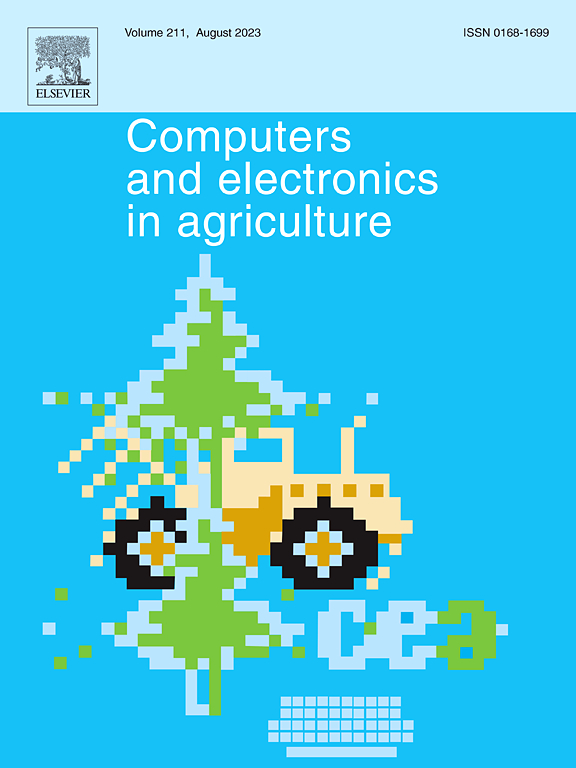A scene-adaptive reseeding system with missed seeding detection for double-disc air-suction seed meter based on an improved YOLOv8n algorithm
IF 8.9
1区 农林科学
Q1 AGRICULTURE, MULTIDISCIPLINARY
引用次数: 0
Abstract
In precision seeding operations, the detection of missed seeds and the subsequent reseeding process are pivotal for enhancing seeding accuracy and maximizing crop yield. This study presents a scene-adaptive reseeding system with missed seeding detection for a double-disc air-suction seed meter, based on an improved YOLOv8n algorithm. The system is composed of several integral components, including a missed seeding detection module, the double-disc air-suction seed meter, a scene-adaptive reseeding module, and a central controller, among others. Industrial cameras are employed to dynamically capture images within the seed meter, which, in combination with the refined YOLOv8n model, ensures precise detection of missed seeding events. The system identifies 18 distinct missed seeding scenarios and incorporates six distinct dual-phase reseeding strategies tailored to address varying operational conditions. The central controller, guided by detection results and preset logic, actuates a permanent magnet synchronous motor (PMSM) through field-oriented control (FOC), enabling adaptive reseeding and ensuring stable motor operation with a millisecond-level response. Ablation tests reveal that the enhanced YOLOv8n model improved detection precision (P) by 4 % over the original model, while its inference speed surged to 303.03 FPS. This enhancement significantly bolstered both detection accuracy and speed, while maintaining the model’s lightweight nature. Bench tests indicated that, within a speed range of 8–16 km/h, the system achieved an average monitoring accuracy exceeding 91 % for seeding count, reseeding count, and missed seeding count. The minimum detection accuracy for damaged seeds was 82.86 %. Upon incorporating the compensation system, seeding accuracy increased by 0.15 % to 2.89 %. The most significant compensation effect was observed within the 10–14 km/h speed range, where the maximum increase approached 3 %. Kruskal–Wallis test results indicated that speed had a marked influence on reseeding performance; at lower speeds, overcompensation occurred, while higher speeds led to a decrease in reseeding accuracy. The missed seeding detection and scene-adaptive reseeding system proposed herein proved both effective and feasible, demonstrating superior accuracy and stability when operating within a speed range of 10–14 km/h. It meets the requirements for missed seeding detection and adaptive reseeding for double-disc air-suction seed meters, thus contributing significantly to the advancement of automation and intelligent systems in high-speed precision seeding operations.
基于改进YOLOv8n算法的双盘式空气吸收式播种机现场自适应播漏检测系统
在精确播种作业中,漏种的检测和随后的补播过程对于提高播种精度和最大限度地提高作物产量至关重要。提出了一种基于改进的YOLOv8n算法的双盘空气吸收式播种机场景自适应播漏检测系统。该系统由漏播检测模块、双盘空气吸种仪、场景自适应补播模块和中央控制器等组成。采用工业相机动态捕获种子计内的图像,结合改进的YOLOv8n模型,确保精确检测错过的播种事件。系统识别了18种不同的错过播种情景,并结合了6种不同的双阶段播种策略,以适应不同的操作条件。中央控制器在检测结果和预设逻辑的指导下,通过磁场定向控制(FOC)驱动永磁同步电机(PMSM),实现自适应补种,并确保电机在毫秒级响应下稳定运行。烧蚀实验表明,改进后的YOLOv8n模型检测精度比原模型提高了4%,推理速度提高到303.03 FPS。这种增强显着提高了检测精度和速度,同时保持了模型的轻量级性质。台架试验表明,在8 ~ 16 km/h的速度范围内,该系统对播种次数、补播次数和漏播次数的平均监测精度超过91%。损坏种子的最低检测准确率为82.86%。采用补偿系统后,播种精度提高了0.15%,达到2.89%。在10-14 km/h速度范围内观察到最显著的补偿效果,最大增幅接近3%。Kruskal-Wallis检验结果表明,播种速度对播种性能有显著影响;在较低的速度下,会出现过度补偿,而较高的速度会导致补播精度下降。本文提出的漏播检测和场景自适应补播系统是有效可行的,在10 ~ 14 km/h的速度范围内运行时,具有良好的精度和稳定性。满足双盘式空气吸种仪漏播检测和自适应补播的要求,为高速精密播种作业自动化、智能化的先进性做出了重要贡献。
本文章由计算机程序翻译,如有差异,请以英文原文为准。
求助全文
约1分钟内获得全文
求助全文
来源期刊

Computers and Electronics in Agriculture
工程技术-计算机:跨学科应用
CiteScore
15.30
自引率
14.50%
发文量
800
审稿时长
62 days
期刊介绍:
Computers and Electronics in Agriculture provides international coverage of advancements in computer hardware, software, electronic instrumentation, and control systems applied to agricultural challenges. Encompassing agronomy, horticulture, forestry, aquaculture, and animal farming, the journal publishes original papers, reviews, and applications notes. It explores the use of computers and electronics in plant or animal agricultural production, covering topics like agricultural soils, water, pests, controlled environments, and waste. The scope extends to on-farm post-harvest operations and relevant technologies, including artificial intelligence, sensors, machine vision, robotics, networking, and simulation modeling. Its companion journal, Smart Agricultural Technology, continues the focus on smart applications in production agriculture.
 求助内容:
求助内容: 应助结果提醒方式:
应助结果提醒方式:


